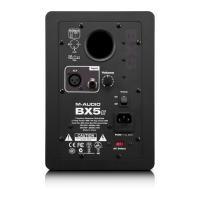
Do you have a question about the M-Audio BX5 D2 and is the answer not in the manual?
| Tweeter | Yes |
|---|---|
| Speaker type | 2-way |
| Number of drivers | 2 |
| Speaker placement | Tabletop/bookshelf |
| Audio output channels | 2.0 channels |
| Tweeter diameter (imperial) | 1 \ |
| Subwoofer driver diameter (imperial) | 5 \ |
| Product color | Black |
| Volume control | Rotary |
| Housing material | MDF |
| Recommended usage | Other |
| Suitable for outdoor use | - |
| Impedance | 20000 Ω |
| Sensitivity | 90 dB |
| Frequency range | 53 - 22000 Hz |
| RMS rated power | 70 W |
| Crossover frequency | 3000 Hz |
| Signal-to-Noise Ratio (SNR) | 100 dB |
| Connectivity technology | Wired |
| 6.35 mm (1⁄4-inch) input | 1 |
| AC input voltage | 115 - 230 V |
| Power source type | AC |
| AC input frequency | 50 - 60 Hz |
| Depth | 176 mm |
|---|---|
| Width | 195 mm |
| Height | 252 mm |
| Weight | 10000 g |
Introduces the BX5 D2 studio monitors and their purpose in audio environments.
Lists all items included in the BX5 D2 speaker package.
Provides links and information for system requirements and product support.
Details the specific components and design aspects of the BX5 D2 monitors.
Details the connectors and controls located on the rear panel of the BX5 D2.
Explains how to adjust the output sound pressure level using the volume control.
Describes the switch used to turn the monitor on and off.
Indicates where to connect the detachable AC power cord.
Identifies the location of the external main fuse.
Details the switch for selecting AC voltage (115V/230V) for proper operation.
Identifies the Power LED, HF Driver, and LF Driver on the front panel.
Provides essential precautions for handling, power, and connections during setup.
Details specific methods for connecting using XLR, TRS, and to audio sources.
Provides guidelines for optimal positioning of the BX5 D2 monitors.